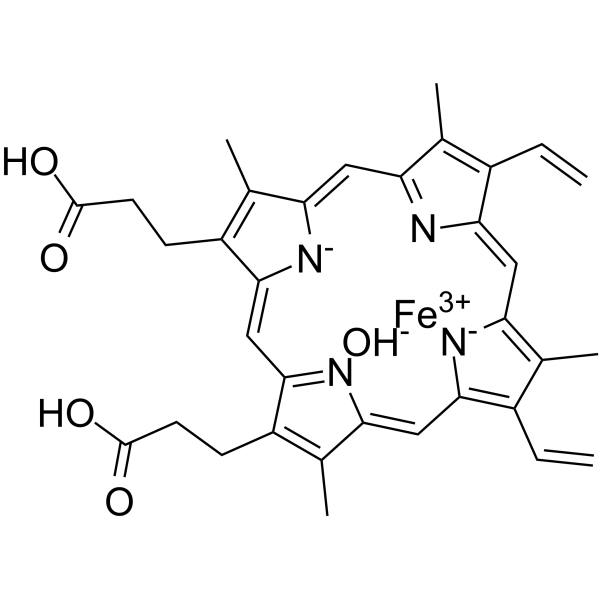15489-90-4
| Name | hematin |
|---|---|
| Synonyms |
Hydroxy[dihydrogen Protoporphyrin IX-ato(2-)]iron
ferriprotoporphyrin IX hydroxide [Dihydrogen 3,7,12,17-Tetramethyl-8,13-divinyl-2,18-porphinedipropionato(2-)]hydroxyiron ferriporphyrin hydroxide heme BOVINE HEMIN ferriheme hydroxide Hydroxy[3,3'-(3,7,12,17-tetramethyl-8,13-divinyl-2,18-porphyrindiyl-κN,N)dipropanoato(2-)]iron ferrihemate Hematin porcine Hematin Iron, [8,13-diethenyl-3,7,12,17-tetramethyl-21H,23H-porphine-2,18-dipropanoato(2-)-κN,κN]hydroxy- ferriprotoporphyrin IX haem ferriprotoporphyrin basic iron protoporphyrin IX MFCD00011615 HAEMATIN HO-Fe(III)(protoporphyrin) hydroxyhemin phenodin ferriheme (SP-5-13)-[7,12-Diethenyl-3,8,13,17-tetramethyl-21H,23H-porphine-2,18-dipropanoato(4-)-N21,N22,N23,N24]oxyferrate(2-) Dihydrogen EINECS 239-518-9 |
| Description | Hematin, an iron-containing porphyrin, inhibits the activity of clotting factors and also fibrin clot lysis through the mechanism of binding to and inactivation of hemostatic proteins[1]. Hematin can be used for the research of acute porphyrias and cancer[1][2][3][4][5]. |
|---|---|
| Related Catalog | |
| In Vitro | Hematin (0.01 mg/ml) inhibits the clotting of bovine fibrinogen (1.3 to 2.6 mg/ml) by bovine thrombin (0.12 U/ml) and inhibits the hydrolysis of a synthetic substrate by human thrombin[2]. Hematin (0.035 mg/ml) reduces VIII:C activity from 0.88 to 0.40 U/ml[2]. Hematin (0.05 mg/ml) inhibits the activation of VIII:C by thrombin (0.04 U/ml)[2]. Hematin (0.09 mg/ml) inhibits the hydrolysis of a synthetic substrate by plasmin[2]. |
| In Vivo | Hematin (i.v.; single injection) suppressed porphyrin production in SD rat (weighing 160-205 g)[4]. |
| References |
| Boiling Point | 1128.5ºC at 760 mmHg |
|---|---|
| Melting Point | 180ºC |
| Molecular Formula | C34H33FeN4O5 |
| Molecular Weight | 633.495 |
| Flash Point | 636.3ºC |
| Exact Mass | 633.180054 |
| PSA | 129.41000 |
| LogP | 3.43290 |
| Vapour Pressure | 0mmHg at 25°C |
| Storage condition | 2~8°C |
Synonym: Section 2 - COMPOSITION, INFORMATION ON INGREDIENTS
Risk Phrases: None Listed. Section 3 - HAZARDS IDENTIFICATION EMERGENCY OVERVIEW
The toxicological properties of this material have not been fully investigated. Potential Health Effects Eye: May cause eye irritation. Skin: May cause skin irritation. Ingestion: The toxicological properties of this substance have not been fully investigated. Inhalation: May cause respiratory tract irritation. The toxicological properties of this substance have not been fully investigated. Chronic: Not available. Section 4 - FIRST AID MEASURES Eyes: Flush eyes with plenty of water for at least 15 minutes, occasionally lifting the upper and lower eyelids. Get medical aid. Skin: Get medical aid. Flush skin with plenty of water for at least 15 minutes while removing contaminated clothing and shoes. Ingestion: Get medical aid. Wash mouth out with water. Inhalation: Remove from exposure and move to fresh air immediately. If not breathing, give artificial respiration. If breathing is difficult, give oxygen. Get medical aid. Notes to Physician: Section 5 - FIRE FIGHTING MEASURES General Information: As in any fire, wear a self-contained breathing apparatus in pressure-demand, MSHA/NIOSH (approved or equivalent), and full protective gear. Extinguishing Media: Use water spray, dry chemical, carbon dioxide, or chemical foam. Section 6 - ACCIDENTAL RELEASE MEASURES General Information: Use proper personal protective equipment as indicated in Section 8. Spills/Leaks: Vacuum or sweep up material and place into a suitable disposal container. Section 7 - HANDLING and STORAGE Handling: Avoid breathing dust, vapor, mist, or gas. Avoid contact with skin and eyes. Storage: Store in a cool, dry place. Store in a tightly closed container. Section 8 - EXPOSURE CONTROLS, PERSONAL PROTECTION Engineering Controls: Use adequate ventilation to keep airborne concentrations low. Exposure Limits CAS# 15489-90-4: Personal Protective Equipment Eyes: Not available. Skin: Wear appropriate protective gloves to prevent skin exposure. Clothing: Wear appropriate protective clothing to prevent skin exposure. Respirators: Follow the OSHA respirator regulations found in 29 CFR 1910.134 or European Standard EN 149. Use a NIOSH/MSHA or European Standard EN 149 approved respirator if exposure limits are exceeded or if irritation or other symptoms are experienced. Section 9 - PHYSICAL AND CHEMICAL PROPERTIES Physical State: Solid Color: black Odor: Not available. pH: Not available. Vapor Pressure: Not available. Viscosity: Not available. Boiling Point: Not available. Freezing/Melting Point: Not available. Autoignition Temperature: Not available. Flash Point: Not available. Explosion Limits, lower: Not available. Explosion Limits, upper: Not available. Decomposition Temperature: Solubility in water: Specific Gravity/Density: Molecular Formula: Molecular Weight: Section 10 - STABILITY AND REACTIVITY Chemical Stability: Unstable. Conditions to Avoid: Not available. Incompatibilities with Other Materials: Not available. Hazardous Decomposition Products: Carbon monoxide, oxides of nitrogen, carbon dioxide. Hazardous Polymerization: Will not occur. Section 11 - TOXICOLOGICAL INFORMATION RTECS#: CAS# 15489-90-4: NO6725000 LD50/LC50: Not available. Carcinogenicity: HEMATIN, FROM BOVINE BLOOD - Not listed by ACGIH, IARC, or NTP. Other: See actual entry in RTECS for complete information. Section 12 - ECOLOGICAL INFORMATION Section 13 - DISPOSAL CONSIDERATIONS Dispose of in a manner consistent with federal, state, and local regulations. Section 14 - TRANSPORT INFORMATION IATA Not regulated as a hazardous material. IMO Not regulated as a hazardous material. RID/ADR Not regulated as a hazardous material. Section 15 - REGULATORY INFORMATION European/International Regulations European Labeling in Accordance with EC Directives Hazard Symbols: Not available. Risk Phrases: Safety Phrases: S 24/25 Avoid contact with skin and eyes. WGK (Water Danger/Protection) CAS# 15489-90-4: No information available. Canada None of the chemicals in this product are listed on the DSL/NDSL list. CAS# 15489-90-4 is not listed on Canada's Ingredient Disclosure List. US FEDERAL TSCA CAS# 15489-90-4 is not listed on the TSCA inventory. It is for research and development use only. SECTION 16 - ADDITIONAL INFORMATION N/A |
CHEMICAL IDENTIFICATION
HEALTH HAZARD DATAACUTE TOXICITY DATA
|
| Personal Protective Equipment | Eyeshields;Gloves;type N95 (US);type P1 (EN143) respirator filter |
|---|---|
| Hazard Codes | Xi |
| RIDADR | NONH for all modes of transport |
| WGK Germany | 3.0 |
|
~% 
15489-90-4 |
| Literature: Organic and Biomolecular Chemistry, , vol. 10, # 31 p. 6375 - 6387 |


